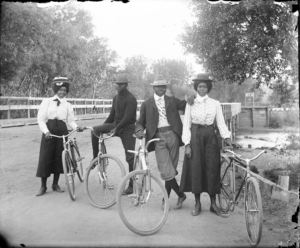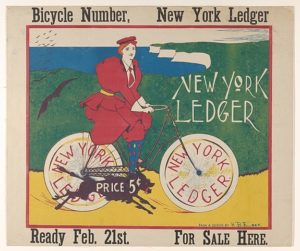
The cycling craze crisscrossed the nation, with cycling clubs and events clustered in western cities.
Anya Jabour
On August 30, 1895, May Bragdon and her friends enjoyed “a perfectly delightful day” in and around Rochester, New York. After dinner, the group mounted their bicycles and rode to Ontario Beach Park, arriving just at sunset for a performance of “Pinafore” at the pavilion, where they also relished “the stars & gorgeous moon & colored lights & flowers & sweet air!” Afterward, May and her companions returned home on their “wheels.” “After the first long hill it was simply inexpressibly fine,” May gushed in the pages of her diary that night. “The still, dewy night—the outdoor odors—the white smooth road]. The gorgeously bright moon & stars & the sense of freedom & exhilaration of the wheel’s motion!”
Thanks in part to the widespread adoption of the bicycle, the late nineteenth century represented a new era of “freedom & exhilaration” for American women, especially well-to-do white women like May Bragdon and her friends. Although a few intrepid athletes had experimented with the “pennyfarthing” bicycle earlier, in the late 1880s, the introduction of the “safety” bike—featuring pneumatic wheels of the same size—vastly expanded the popularity of “wheeling.” By the mid-1890s, estimates of the number of US bicyclists ranged between 2 and 4 million.

The cycling craze crisscrossed the nation, with cycling clubs and events clustered in western cities such as Denver and Phoenix as well as in eastern cities such as New York and Boston. Enthusiasm for cycling also crossed racial lines—to a point. Although affluent African Americans took up cycling in the 1890s, wheeling remained a racially segregated activity. Even so, Black women eagerly adopted cycling—and excelled at it. Boston native Katherine Towle Knox joined the League of American Wheelmen in 1893, a year before that organization officially excluded African Americans. Knox gained acclaim for her competitive racing, trick riding, and cycling costumes, and she used her unique status to challenge racial segregation. Boston also was home to Irish, Italian, and Chinese cyclists.
Whatever their race or ethnicity, only well-to-do Americans could afford to take up cycling. The high cost of bicycles in the 1890s—between $25 and $50 for a new “wheel,” the equivalent of $800 to $1600 today—was prohibitive for working-class Americans. But above all, cycling was a quintessentially feminine pursuit; indeed, the “safety” bike featured a dropped frame that accommodated women’s long skirts.
Although members of other groups certainly cycled, the prototypical cyclist in Victorian America was a well-to-do white woman. Public discussions of cycling revolved around the “New Woman,” invariably depicted as young, white, and attractive. Illustrator Charles Dana Gibson popularized the image of the turn-of-the-century’s liberated woman with his drawings of the “Gibson Girl,” who eagerly engaged in sports. Popular publications reinforced the association between women and cycling. “The typical girl of the present period is the bicycle girl,” announced Ladies’ World in 1896. That same year, Bicycling for Ladies offered both practical and fashionable tips for female cyclists.
Click here for reading Full Article
______________
Anya Jabour is Regents Professor of History and Director of the Public History Program at the University of Montana. The author, most recently, of Sophonisba Breckinridge: Championing Women’s Activism in Modern America (University of Illinois Press, 2019), she currently is writing a biography of Katharine Bement Davis (1860-1935).
Courtesy: Common Place